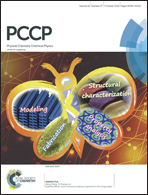18-Electron rule inspired Zintl-like ions composed of all transition metals†
Abstract
Zintl phase compounds constitute a unique class of compounds composed of metal cations and covalently bonded multiply charged cluster anions. Potential applications of these materials in solution chemistry and thermoelectric materials have given rise to renewed interest in the search for new Zintl ions. Up to now these ions have been mostly composed of group 13, 14, and 15 post-transition metal elements and no Zintl ions composed of all transition metal elements are known. Using gradient corrected density functional theory we show that the 18-electron rule can be applied to design a new class of Zintl-like ions composed of all transition metal atoms. We demonstrate this possibility by using Ti@Au122− and Ni@Au62− di-anions as examples of Zintl-like ions. Predictive capability of our approach is demonstrated by showing that FeH64− in an already synthesized complex metal hydride, Mg2FeH6, is a Zintl-like ion, satisfying the 18-electron rule. We also show that novel Zintl phase compounds can be formed by using all transition metal Zintl-like ions as building blocks. For example, a two-dimensional periodic structure of Na2[Ti@Au12] is semiconducting and nonmagnetic while a one-dimensional periodic structure of Mg[Ti@Au12] is metallic and ferromagnetic. Our results open the door to the design and synthesis of a new class of Zintl-like ions and compounds with potential for applications.


 Please wait while we load your content...
Please wait while we load your content...